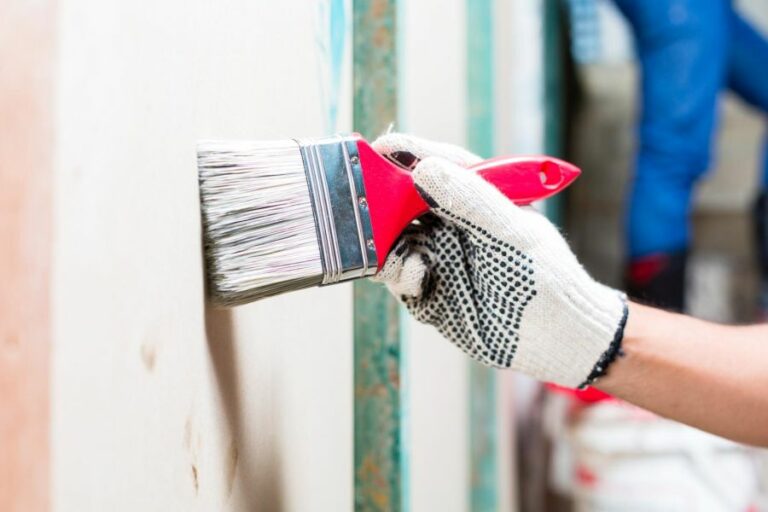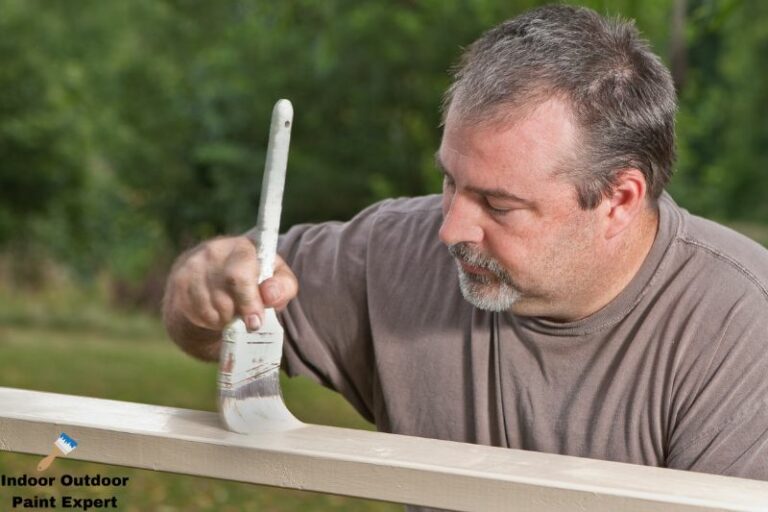Outdoor Enamel Paint, 25 Things You Should Know
Outdoor enamel paint is essential when taking on an exterior painting project to achieve a durable, weather-resistant, and aesthetically appealing result. As an expert in the field, I can confidently guide you through the process, ensuring you make the right selection for your needs.
Outdoor enamel paint:
Outdoor enamel paint is durable, weather-resistant, and ideal for protecting and beautifying exterior surfaces. It offers excellent longevity, resistance to fading, moisture protection, and versatility, making it suitable for wood, metal, concrete, and masonry. Types include oil-based, latex-based, and acrylic enamels, each with unique properties and finishes. Proper surface preparation and application techniques are essential for a long lasting, vibrant finish.

Discover the magic of outdoor enamel paint and how it can transform your space from drab to fab! Read on to uncover the secrets of this versatile product, learn about its unique properties, and understand why it’s the perfect choice for your next DIY project. Your home improvements will never be the same!
Contents
- 1 Exterior Enamel Paint for Outdoor Surfaces
- 2 Is Enamel Paint Suitable for Outdoor Applications?
- 3 Does Enamel Paint Possess Weather-Resistant Properties?
- 4 Does enamel corrode when exposed to outdoor elements?
- 5 Is Water-Based Enamel Suitable for Exterior Use?
Exterior Enamel Paint for Outdoor Surfaces
Outdoor enamel paint is a popular choice for homeowners, DIY enthusiasts, and professional painters when it comes to beautifying and protecting exterior surfaces.
Known for its exceptional durability, resistance to various weather conditions, and vibrant finish, enamel paint provides a long-lasting and appealing look to a variety of surfaces.
• Understanding the Benefits of Outdoor Enamel Paint
There are several reasons why outdoor enamel paint is a preferred choice for external surfaces, including:
– Durability
Enamel paint is known for its longevity and ability to withstand harsh weather conditions, including rain, snow, and sun exposure. This means it’s an excellent choice to protect your surfaces for years to come.
– Resistance to Fading
Due to its unique formulation, outdoor enamel paint is highly resistant to fading, even when exposed to direct sunlight for extended periods of time. This ensures your surfaces will maintain their vibrant color and appeal.
– Protection from Moisture
Enamel paint creates a protective barrier against moisture penetration, significantly reducing the risk of mold, mildew, and water damage. This is particularly important for outdoor surfaces, where constant exposure to moisture can cause extensive damage over time.
– Versatility
Enamel paint is suitable for a wide range of surfaces and materials, including wood, metal, concrete, and masonry. This means that you can use it for various applications, such as painting outdoor furniture, house exteriors, fences, and more.
• Choosing the Right Outdoor Enamel Paint
There are several factors to consider when selecting outdoor enamel paint, including:
– Type of Enamel Paint
Enamel paint is available in oil-based, water-based (latex), and acrylic formulations. Oil-based enamel is known for its excellent durability, glossy finish, and strong adherence to surfaces. However, it dries slowly and is not environmentally friendly due to its high VOC content.
The latex-based enamel is more environmentally friendly, dries faster, and is easier to clean up while still offering good durability and adhesion.
Acrylic enamel provides a balance between the properties of oil and latex-based enamels, offering excellent durability, lower VOC content, and easy cleanup. It is also less likely to yellow over time.
– Finish
Outdoor enamel paint is available in various finishes, including gloss, semi-gloss, satin, and flat. Gloss and semi-gloss finishes are durable and easy to clean, making them ideal for surfaces that require frequent maintenance, such as doors and window frames.
Satin and flat finishes offer a more understated look and work well on larger surfaces like walls and fences.
– Color
When choosing a color for your outdoor enamel paint, consider the overall aesthetic of your home or project, as well as the surrounding environment.
Keep in mind that lighter colors tend to reflect more sunlight and can help keep surfaces cool in hot climates, while darker colors can absorb heat and may be more suitable for cooler climates. Consult color charts from reputable paint manufacturers to help you decide on the perfect hue.
• Preparing Surfaces for Outdoor Enamel Paint
Proper surface preparation is key to achieving a smooth, long-lasting finish with enamel paint. Follow these expert recommendations for surface preparation:
- Cleaning: Remove dirt, grease, and other contaminants using a mild detergent or a specialized cleaner designed for the specific material you’re working with. For more difficult stains, consider using a pressure washer.
- Remove loose paint and debris: Scrape away any loose or peeling paint using a scraper, wire brush, or sandpaper. Ensure your surface is free of any debris that could interfere with paint adhesion.
- Repair damage: Fill any holes, cracks, or other imperfections with a suitable filler, then sand the area smoothly once it’s dry.
- Priming: Apply a primer appropriate for your surface material and allow it to dry completely before applying enamel paint. A primer will help seal porous surfaces and create a smooth, even base that enhances paint adhesion.
• Applying and Cleaning Up Outdoor Enamel Paint
Follow these tips for a successful paint application and cleanup:
- Paint application: Stir your enamel paint thoroughly, then use a brush, roller, or sprayer to apply it to your surface. Apply multiple thin coats, allowing each coat to dry according to the manufacturer’s instructions before applying the next.
- Painting in ideal conditions: Outdoor enamel paint should be applied when temperatures are between 50°F and 90°F, and humidity levels are below 85% to ensure proper drying and adherence. Avoid painting in direct sunlight or strong winds, as these can affect drying times and paint application.
- Cleanup: Cleanup procedures will depend on the type of enamel paint you’re using. Latex and acrylic enamel paints can be cleaned up with water, while oil-based enamel requires the use of mineral spirits or paint thinner. Always dispose of paint waste and solvents responsibly, following local regulations.
By selecting the appropriate outdoor enamel paint, properly preparing your surfaces, and adhering to expert application techniques, you can achieve a durable, vibrant finish that will stand the test of time.
Visit The Environmental Protection Agency for tips on responsible paint disposal and management to further ensure a safe and successful project.
Is Enamel Paint Suitable for Outdoor Applications?
Enamel paint is a popular choice among homeowners and professionals for its durability, versatility, and glossy finish. But can it be used outside? In short, yes. In fact, enamel paint is an ideal option for outdoor applications due to its strong resistance to natural elements such as sunlight, moisture, and rust.
• Properties of Enamel Paint
Enamel paint is a type of oil-based paint with qualities that make it suitable for outdoor applications. Some of its properties are:
– Durability
Enamel paint is well-known for its long-lasting durability. Thanks to its oil-based composition, enamel paint forms a hard, protective shell when it dries. This shell can withstand a variety of weather conditions without easily chipping, peeling, or fading.
– UV Resistance
Exterior surfaces exposed to direct sunlight require paints resistant to UV rays to prevent fading and discoloration. Enamel paint offers excellent UV resistance, making it an ideal choice for outdoor applications.
– Moisture Resistance
Enamel paint is highly resistant to moisture, making it suitable for surfaces exposed to rain, dew, and humidity. Its waterproof properties can also prevent the growth of mold and mildew on exterior surfaces.
– Rust Resistance
One of the most significant benefits of using enamel paint is its rust-resistant properties. When applied on metal surfaces, enamel paint forms a protective barrier that helps prevent rust formation and corrosion.
• Outdoor Applications: Advantages and Disadvantages
Enamel paint comes with several advantages and disadvantages when used for outdoor projects. Let’s take a closer look at both.
– Advantages of Using Enamel Paint Outdoors
- Durability: As mentioned earlier, enamel paint is incredibly durable and can withstand harsh weather conditions without easily chipping, peeling, or fading.
- Low Maintenance: Due to its robust nature, outdoor surfaces painted with enamel paint usually require minimal maintenance, saving you time and effort in the long run.
- Aesthetic Appeal: With its glossy finish, enamel paint can enhance the visual appeal of various surfaces, giving them a polished, professional, and sophisticated appearance.
- Protection Against Corrosion: Enamel paint provides an added layer of protection against rust and corrosion, making it ideal for metal surfaces such as gates, railings, and outdoor furniture.
– Disadvantages of Using Enamel Paint Outdoors
- Long Drying Times: Enamel paint often takes longer to dry compared to other paint types, which can be an inconvenience during outdoor painting projects.
- Limited Color Options: Traditional enamel paints may have a limited range of color options compared to modern, water-based paints.
- VOC Emissions: Being oil-based, enamel paint contains volatile organic compounds (VOCs) that can be harmful to the environment and the user’s health. It is essential to ensure proper ventilation during application and choose low-VOC or VOC-free enamel paints if possible.
• Recommendations for Using Enamel Paint Outdoors
From personal experience, here are some recommendations for working with enamel paint on exterior surfaces:
- Surface Preparation: Properly clean, sand, and prime the surface before applying enamel paint to ensure a smooth, long-lasting finish. For metal surfaces, use a rust-inhibiting primer for added protection.
- Choose the Right Paint: Look for enamel paint specifically designed for outdoor use. The label should indicate that it is weather-resistant, UV-resistant, and moisture-resistant. For a more environmentally friendly option, choose low-VOC or VOC-free versions.
- Application: Apply multiple thin coats of enamel paint, allowing each coat to dry completely before applying the next. This will ensure a durable, even finish.
- Weather Conditions: Prioritize painting on days with mild temperatures and low humidity. Avoid painting in direct sunlight, as it can cause the paint to dry too quickly, leading to an uneven finish.
- Proper Ventilation: Make sure to have adequate ventilation when using enamel paint. This will help disperse harmful fumes and ensure a safer working environment.
In conclusion, enamel paint is an excellent choice for outdoor applications due to its durability, UV resistance, moisture resistance, and rust-preventing properties.
When applied correctly on well-prepared surfaces, enamel paint offers long-lasting protection and aesthetic appeal to a variety of exterior surfaces.
For more information about enamel paint, check out this guide from the National Institute of Standards and Technology.
Does Enamel Paint Possess Weather-Resistant Properties?
When it comes to painting outdoor surfaces, a common concern is whether the chosen paint can withstand the often-harsh effects of weather.
Among the different types of paint available in the market, enamel paint is a popular choice for painting surfaces that are exposed to the elements. The durability and weather resistance of enamel paint has been proven time and again.
• Factors Contributing to Weather Resistance in Enamel Paint
Enamel paint is known for its ability to provide a durable and tough finish, making it an ideal choice for outdoor surfaces exposed to various weather conditions. Here are some factors that contribute to the weather resistance of enamel paint:
– Composition of Enamel Paint
The composition of enamel paint plays a significant role in its weather resistance. Enamel paints are made of a combination of solvents, pigments, and additives that all contribute to their overall durability.
Among these are alkyd resins, which provide extra layers of protection against moisture, UV rays, and other harsh external factors. The presence of high-quality ingredients in enamel paint enhances its ability to withstand changing weather conditions over long periods without deteriorating.
– Advanced Formulations for Improved Weather Resistance
Technological advancements have made it possible to create enamel paints that offer even better weather resistance.
For example, there are now waterborne enamel paints that are as durable as their oil-based counterparts but have lower VOCs (volatile organic compounds) and are less likely to yellow over time.
Additionally, manufacturers also produce enamel paints formulated with UV resistance or added rust inhibitors, further enhancing their weather resistance capability (source).
• Recommended Practices for Optimal Weather Resistance
To ensure that the enamel paint provides the best possible weather resistance, follow these recommendations:
– Proper Surface Preparation
A vital step to ensure the weather resistance of enamel paint is adequate surface preparation. Be sure to clean the surface thoroughly, removing any dirt, debris, or loose paint. If needed, use a wire brush or sandpaper to scrape off any old, peeling paint or rust.
Additionally, ensure that the surface is dry and free from any moisture before painting.
– Primer Application
Using a primer before applying the enamel paint helps improve the surface’s adhesion, providing a better base for the paint to stick to. Priming the surface also helps in achieving a uniform finish by blocking any stains and preventing them from bleeding through the paint.
When dealing with a metal surface, a rust-inhibiting primer might be necessary for maximum protection.
– Appropriate Environmental Conditions for Painting
Choose the right time and weather conditions for painting. According to the U.S. Department of Agriculture, enamel paint is best applied in dry conditions with temperatures between 50F and 90F (10C and 32C).
Cooler temperatures and high humidity levels can negatively affect the drying and curing process, which may reduce the paint’s durability and weather resistance.
– Applying Multiple Coats
As a rule of thumb, applying multiple thin coats of enamel paint is more effective than putting on a single thick layer. Thin coats dry more evenly and allow the paint to cure properly, resulting in a more durable and weather-resistant finish.
Moreover, additional coats provide added protection, making the painted surface more resilient against the elements.
• Final Thoughts
In conclusion, enamel paint is indeed weather resistant, making it a highly suitable choice for painting surfaces exposed to various weather conditions. Factors such as the composition of enamel paint and advancements in paint formulations enhance its weather resistance.
To make the most out of enamel paint, ensure proper surface preparation and follow the recommended practices mentioned in this article. By doing so, you can expect a durable, long-lasting, and weather-resistant finish that keeps your outdoor surfaces protected and looking good for years to come.
Does enamel corrode when exposed to outdoor elements?
I will cover everything you need to know about enamel and whether it rusts outside. We will explore the properties of enamel, its various applications, its exposure to outdoor elements, and measures to take to prevent rusting.
This comprehensive understanding of enamel will provide you with insights into how it can be utilized effectively for various outdoor purposes.
• Understanding Enamel and Its Properties
Enamel is a hard, glossy substance that forms a protective coating on various substrates, such as metals or ceramics. It is commonly used in various industries due to its excellent aesthetic appeal, resistance to wear and corrosion, and ability to withstand extreme temperatures.
The two main types of enamel are vitreous enamel, which is powdered glass fused onto a substrate, and synthetic enamel, which comprises a mixture of resins and pigments.
Characteristics of enamel include:
- Heat Resistance: Enamel has a high resistance to heat, making it ideal for applications where heat resistance is required, such as cookware and automotive parts.
- Corrosion Resistance: Enamel coatings form a non-porous barrier on surfaces that protect them from chemicals, moisture, and other potential corrosive agents.
- Color Retention: Enamel maintains its vibrant colors and gloss even when exposed to environmental factors, contributing to its aesthetic appeal.
- Durability: Due to its hard surface, enamel can resist scratches and wear, contributing to its extended lifespan.
• Applications of Enamel for Outdoor Use
Given its protective properties, the enamel is widely used in many outdoor applications. Some of the most common ways enamel is used outdoors include:
- Signage: Enamel is often employed in the creation of outdoor signs due to its color retention and durability. The long-lasting nature of enamel makes it ideal for signs exposed to the elements, requiring minimal maintenance.
- Automotive Parts: Enamel paint is frequently used for car exteriors, providing a glossy and durable finish that resists chipping and rusting.
- Outdoor Furniture and Architecture: Elements such as railings, fences, and benches are coated with enamel for protection from rust and other corrosive agents, as well as to enhance their aesthetic appeal.
- Cookware: Outdoor cooking appliances and utensils, such as barbecue grills, often feature an enamel coating to ensure heat resistance, ease of cleaning, and durability.
• Exposure to Outdoor Elements: Rusting and Its Impacts
Despite enamel’s excellent protective features, it may still be exposed to the elements outdoors, potentially leading to rusting.
Rust, or iron oxide, occurs when iron or a ferrous-containing material reacts with oxygen in the presence of moisture. Rust can weaken the material’s structural integrity and lead to its eventual disintegration.
While enamel itself does not rust, it may compromise the underlying metal substrate if chipped or cracked. Such damages may expose the metal to moisture and oxygen, facilitating the formation of rust.
This rust can spread to other areas, causing further damage to the material and eventually affecting the integrity of the enamel layer as well.
• Prevention and Maintenance Measures Against Rust
To maximize the benefits of enamel and its protection against rust, follow these suggestions:
- Choose High-Quality Enamel Products: Make sure to use high-quality enamel products for your outdoor applications. Inferior-quality enamel might not provide adequate protection against rust, resulting in premature damage to the material.
- Proper Application: Ensure that the enamel is applied correctly to the substrate, following manufacturers’ instructions and recommendations. A proper application will help create an effective barrier against rust and other corrosive elements.
- Regular Inspection: Regularly inspect enamel-coated objects for signs of chipping, cracking, or any areas where the coating might have worn off. Early detection and repair will prevent moisture and oxygen from reaching the underlying metal, preventing rust formation.
- Maintenance and Repair: If you notice any damage to the enamel coating, address it promptly by cleaning the area and reapplying enamel as needed. Make sure to use compatible enamel products to ensure they bond effectively with the existing coating.
For further information on the properties and applications of enamel, you may want to visit the American Ceramic Society or the Society for Protective Coatings, as they provide valuable resources in understanding and utilizing enamel effectively for outdoor purposes.
• Conclusion
Enamel offers an array of benefits for outdoor applications due to its durability, corrosion resistance, heat resistance, and color retention. However, it is essential to remember that while enamel itself does not rust, the underlying metal substrate could rust if the enamel coating is damaged.
Taking proper preventive measures and maintaining enamel-coated objects will ensure their long-lasting protection against rust and the elements while preserving their visual appeal for years to come.
Is Water-Based Enamel Suitable for Exterior Use?
Water-based enamel paints are a popular choice for various indoor and outdoor projects due to their distinct advantages when compared to oil-based enamel paints.
However, before deciding to use water-based enamel paint for your next outdoor project, understanding the key characteristics, benefits, and potential limitations can be quite helpful in making an informed decision.
• Characteristics of Water-Based Enamel Paint
– Environmentally Friendly
Water-based enamel, also known as acrylic or latex paint, is an eco-friendly option for outdoor projects. These paints emit lower levels of harmful volatile organic compounds (VOCs) than oil-based paints, making them more environmentally conscious choices.
Furthermore, they also are easier to clean up, requiring only water and soap, as compared to the need for harmful solvents when using oil-based enamels.
– Fast Drying Time
One of the most appreciated features of water-based enamel paint is its quick drying time. The paint can often dry to the touch within an hour and reach full curing in less than a day, which is significantly faster than oil-based counterparts.
This fast drying time can be beneficial for completing outdoor projects efficiently and avoiding potential weather issues.
– Resistance to Yellowing
Water-based enamels retain their color better over time, as they are less prone to yellowing due to their resistance to UV light. This feature is particularly important for outdoor projects as they are exposed to sunlight and the elements.
– Compatibility with Various Surfaces
Although water-based paints can be applied to different surfaces, including wood, metal, concrete, and more, it is essential to select the appropriate formulation designed specifically for that substrate. Additionally, proper surface preparation, such as cleaning, sanding, and priming, is critical to ensuring good adhesion of the paint.
• Limitations of Water-Based Enamel Paint
– Lower Durability
While water-based enamel paint possesses many advantages, one potential drawback is its lower durability compared to oil-based enamels. This limitation can make them more susceptible to scratches, chipping, and wear.
Consequently, selecting the right type of paint, proper surface preparation, and applying an appropriate sealer or topcoat can mitigate this concern.
– Sensitivity to Temperature Changes
Water-based paints can also be sensitive to temperature and humidity changes during the application and drying process.
When painting outdoors, it is crucial to follow the manufacturer’s recommendations for ideal application conditions, as applying paint in extreme temperatures or humidity can lead to reduced adhesion and performance.
• Applications of Water-Based Enamel for Outdoor Projects
– Exterior Woodwork and Trim
Water-based enamel can be a suitable choice for painting exterior woodwork, such as eaves, window frames, and trim, thanks to its resistance to yellowing and ability to withstand varying temperatures. For best results, ensure the surface is adequately prepared and primed before painting.
– Outdoor Furniture
Outdoor furniture made from wood, metal, or plastic can benefit from the use of water-based enamel paint, as it offers a durable, smooth finish that is easy to clean.
When selecting a paint type for your outdoor furniture, consider a formulation that provides extra protection from the elements, such as a product with built-in UV resistance.
– Garden and Yard Decor
Water-based enamel can be used for painting garden ornaments, planters, and other yard decor pieces, as long as the appropriate formulation is chosen for the material type. Seal the painted surface with a suitable sealer or topcoat to ensure longevity in outdoor conditions.
• Conclusion
Water-based enamel paint can be a practical choice for various outdoor projects, offering advantages such as environmentally friendly properties, fast drying time, and resistance to yellowing.
While it has limitations like lower durability and sensitivity to temperature changes, understanding these factors and following best practices can deliver excellent results for your outdoor painting needs.
Ultimately, your project’s success rests upon selecting the right type of paint, surface-specific formula, and proper surface preparation, creating long-lasting and visually appealing results.
Further information on water-based paints and their applications can be found in The Environmental Protection Agency’s Paints and Coatings Resource Guide, which provides a wealth of information on environmentally friendly paint options and recommendations for handling and disposing of paint products properly.







